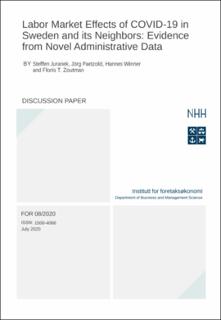| dc.description.abstract | This paper studies the labor market effects of non-pharmaceutical interventions (NPIs) to combat the COVID-19 pandemic. We focus on the Nordic countries which showed one of the highest variations in NPIs despite having similar community spread of COVID-19 at the onset of the pandemic: While Denmark, Finland and Norway imposed strict measures (‘lockdowns’), Sweden decided for much lighter restrictions. Empirically, we use novel administrative data on weekly new unemployment and furlough spells from all 56 regions of the Nordic countries to compare the labor market outcomes of Sweden with the ones of its neighbors. Our evidence suggests that the labor markets of all countries were severely hit by the pandemic, although Sweden performed slightly better than its neighbors. Specifically, we find the worsening of the Swedish labor market to occur around 2 to 3 weeks later than in the other Nordic countries, and that its cumulative sum of new unemployment and furlough spells remained significantly lower during the time period of our study (up to week 21 of 2020). | en_US |
